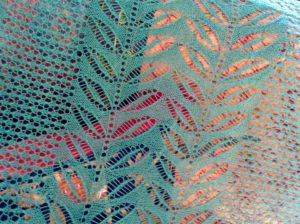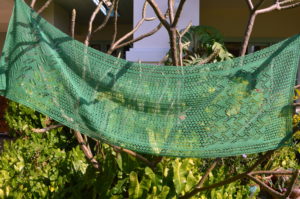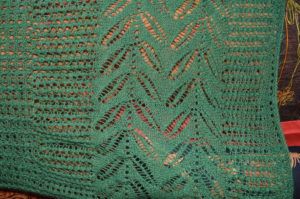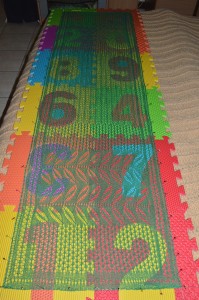 Palm trees grow everywhere in Thailand, from the sea to the mountains, and the landscapes are a lush green throughout the year.
Palm trees grow everywhere in Thailand, from the sea to the mountains, and the landscapes are a lush green throughout the year.
For my newest shawl pattern I decided to incorporate these elements in the design of a shawl that’s a suitable accessory in the tropics year-round, and for spring and summer in less tropical climes.
This soft and elegant rectangular Thai Tropics shawl is knit with Manos lace (2-ply), a blend of baby alpaca, cashmere, and silk, and it’s as luxurious as it sounds! It features a panel of palm fronds and a panel of palm leaves, set against a background of open lacework.
Dimensions after blocking: 18×64 inches (46x162cm)

As you can see from the photos the lace design elements are clearly defined and the piece has a very finished look to it.
It doesn’t come off the needles looking like this, however! That’s one reason the dimensions are noted “after blocking.”
Wet blocking of lace knit items is necessary to stretch out and give shape to the piece, and to open up the lace stitch structure. If you simply stretch the item when it is dry, it will spring back and not maintain the desired shape and size.
Here’s a look at the palm fronds end of my Thai Tropics shawl before blocking:

I should add here that I resisted the blocking step of producing lace knit accessories for quite a while, even though I knew this step was an important one. The whole process looked too difficult and I didn’t have the tools I needed, so I stretched and smoothed the scarves and shawls and went back to my knitting.
I’ve since gone back and wet blocked these pieces, and what a difference it makes!
The process is not complex and the tools are relatively easy to acquire. It helps if you have:
1. Interlocking play mats or blocking mats – I use play mats simply because they cost less and are easy to find in toy stores and many discount or department stores. Blocking mats are considered a specialty item and are considerably more expensive.
2. Knitting blocking wires [or a knitting blocking kit (with pins)] – Threading these wires along the edges of a shawl or scarf ensures a straight edge and helps in the stretching process. Using wires also means using fewer pins.
3. Stainless steel T-pins – If you didn’t get pins with your wires, you should buy some good quality stainless steel pins (to keep them from rusting and staining your knitted item).
There are lots of helpful websites and videos to take you through the wet blocking process, so it doesn’t make sense for me to repeat the steps here.
Here’s an article that I have found to be particularly useful:
http://www.knittersreview.com/article_how_to.asp?article=/review/product/120322_a.asp
And here’s a look at my new Thai Tropics Lace Knit Shawl in the wet blocking process.
I hope you give the pattern a try, and try out the wet blocking technique on your next lace knit accessory.
If you’d like to purchase this shawl, rather than the pattern, it’s available in my Etsy shop (ScarvesShawlsandMore).
Happy knitting – and blocking!
MikeH


When I saw your new shawl, I had to buy it! Your designs are so refreshingly original, unexpected and appealing. The back stories about the designs mean a lot and give each of your designs a wonderful character. Thank you for using your talents and sharing with all of us. Bravo!!!
Thanks for the compliments Donna. I’m so glad to hear that you like my designs. If you have any questions – or comments – when you’re working from the pattern be sure to let me know. I’ll try to keep coming up with designs that you’ll find interesting. Best, Michael